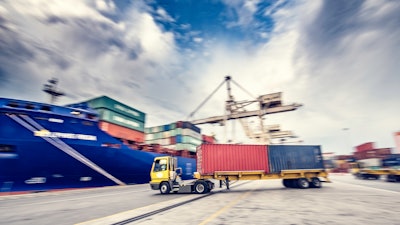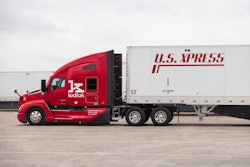
A yard jockey driver, a paper list and a walkie talkie. That’s the antiquated way most LTL carriers handle yard management, even as trucks inch closer to autonomy.
Full autonomy in the yard is a long way off, said John Cesario, vice president of operations at Carrier Logistics Inc. (CLI), but in the meantime, more carriers are transitioning to outdoor wireless systems to increase uptime, provide more transparency around shipments and reduce errors that could further slow the supply chain, among other things.
Roadrunner (CCJ Top 250, No. 99) is one of those carriers.
The company recently transitioned to a wireless yard at its service centers with tablets in its yard jockeys, as well as on its forklifts inside, for real-time updates.
It was one of the changes the company made in its efforts to reduce transit times to increase capacity, and Roadrunner President Frank Hurst said the shift has definitely improved efficiency.
Wireless outdoor systems are becoming more prevalent day by day, paving the way for a day when humans no longer operate this kind of equipment, and it’s the answer to a lot of problems the industry is facing.
The problems it solves
Deryk Powell, president at Velociti Inc., which provides a number of technologies, including autonomy, robotics, Wifi and radio-frequency identification, said autonomy is the solution to the talent shortage and supply chain stagnation. It not only reduces the need for human labor but also is beneficial in retaining drivers by improving satisfaction with shorter wait times at the dock, he said.
But while autonomy is still in its infancy, he said wireless systems can help bridge the gap in the meantime.
CLI President Ben Wiesen said wireless systems improve operating efficiency by using algorithms. For example, systems like CLI’s dock management can determine the most optimal dock for a trailer to back into in order to reduce unloading time based on the freight that’s on the truck and where it’s heading.
“The system can designate which door or spot the trailer is most optimal to be placed in,” Cesario added. “And since the system is all connected – our driver wireless devices are connected to the back office; the back office is connected to the dock; the dock is connected to the yard application – the yard spotter in the new scenario would get task lists – basically what they're supposed to do and in what order – and as they complete tasks, they fall off the list and update the graphical dock management board,” which everyone can see in real time.
“That's the importance of everybody being wirelessly connected,” he said.
Wiesen said wireless connections give insight into a network, providing a better understanding of how equipment flows through each terminal and allowing LTL providers to use that information to adjust line-haul and staffing schedules to increase capacity by keeping trailers moving instead of sitting empty. It can also reduce the potential for human error, he said, often eliminating delays and extra work.
“The benefits are sort of soft from a strategic planning standpoint. The benefits are hard from a cost-saving standpoint. And the benefits are immediate from an error prevention perspective,” Wiesen said.
Coinciding with autonomy
Cesario said yards adding wireless systems is the most immediate change the industry will see, but those systems can later connect with autonomous equipment for more efficiency.
“Down the road, when you get more self-driving vehicles, when that technology improves and arrives at a yard situation, because the technology will already be in place for that task list, if you have well-defined yards and door layouts, you could hopefully one day get rid of that human that's actually doing the work, backing in the trailers and moving them around the yard,” Cesario said. “Not only do you have the overhead of that employee, you have human error, so we want to try to eliminate that human error as far as grabbing the wrong trailer or hitting another trailer.”
Autonomy is coming – not just for trucks but for trailers too, or rather yard jockeys that pull said trailers. It’s already inside warehouses with autonomous forklifts.
Powell said networks have been expanded in recent years to make it possible for yards to become more autonomous.
He said WiFi revolutionized warehousing, trucking and crossdocking when it came out 25 years ago. Such advancements have been made since then to where many companies offer private LTE, increasing bandwidth and speed of connection and latency. With private LTE, he said there is the capability for teleoperated – or remotely driven – material handling devices.
“Because of the speed, latency and bandwidth, I could be sitting on the beach right now operating a forklift in a warehouse in California … We have these remote operators that are basically playing a video game,” Powell said. “What private LTE has been able to do is really open up the capability for autonomy in indoor and outdoor warehouse environments, and so a significant use case there would be automated forklifts.”
He said autonomy will soon be seen in yard jockeys, too.
While autonomous forklifts work great in a warehouse environment, Wiesen said they don’t work as well in a crossdocking environment because of the velocity and variability within such a facility.
“The crossdock has so much loading and unloading onto the truck and putting together the jigsaw that I actually see the opportunity for autonomous vehicles to be more in the yard of moving trailers around, and that's the place I think it's going to hit LTL first,” he said.
While there are some already autonomous yards, they’re more so at places like ports and railheads, but he said that same technology can trickle downstream into the LTL environment.
“While it is still decades away, it’s becoming more prevalent,” Wiesen said. “Warehouse and crossdock environments are already moving toward autonomy with wireless outdoor yard management systems like those that are already on the inside like forklifts moving freight.”
When it’s coming
Wiesen said CLI has placed tremendous emphasis on its crossdock management application, knowing exactly where each shipment is in a facility at all times. He said it is equally important to focus on yard management, and CLI is working on that now.
“There's a real opportunity for efficiency if we pay the same amount of attention to the trailer locations in the yard as there is efficiency gain for how much attention we're paying to the shipment locations on the cross dock,” he said. “The next generation of TMS technology has a chance to really revolutionize that process in taking us away from that walkie talkie, paper-based list, manual checks, and automating a significant amount of it.”
While some yards are closer to that with the use of outdoor wireless systems, Cesario said for full autonomy, technology needs to improve because AI does well when it knows everything it could possibly encounter.
“If you've ever been in an LTL yard or facility, there are a lot of unknowns,” he said. “It's hard to predict every possible scenario that could happen.”
But one day, Powell said, EV and AV will meet where electric yard jockeys combine with autonomous yard jockeys, and the industry will see a fully autonomous yard where autonomous tractors pull trailers into a yard and pick up another as an autonomous yard jockey backs the trailer into the prime dock for loading and unloading.
“It’s super fascinating to think about what it could become,” Powell said.
But in between now and that kind of environment, he said teleoperated vehicles are more realistic.
Wiesen said if a human can do it, sooner or later, a computer is going to be able to do it, too.
“The when is a big question mark. It’s going to be baby steps,” Wiesen said. “Eventually, it will be fully automated, but that eventuality is probably going to be measured in decades – not years and certainly not months or weeks.”













